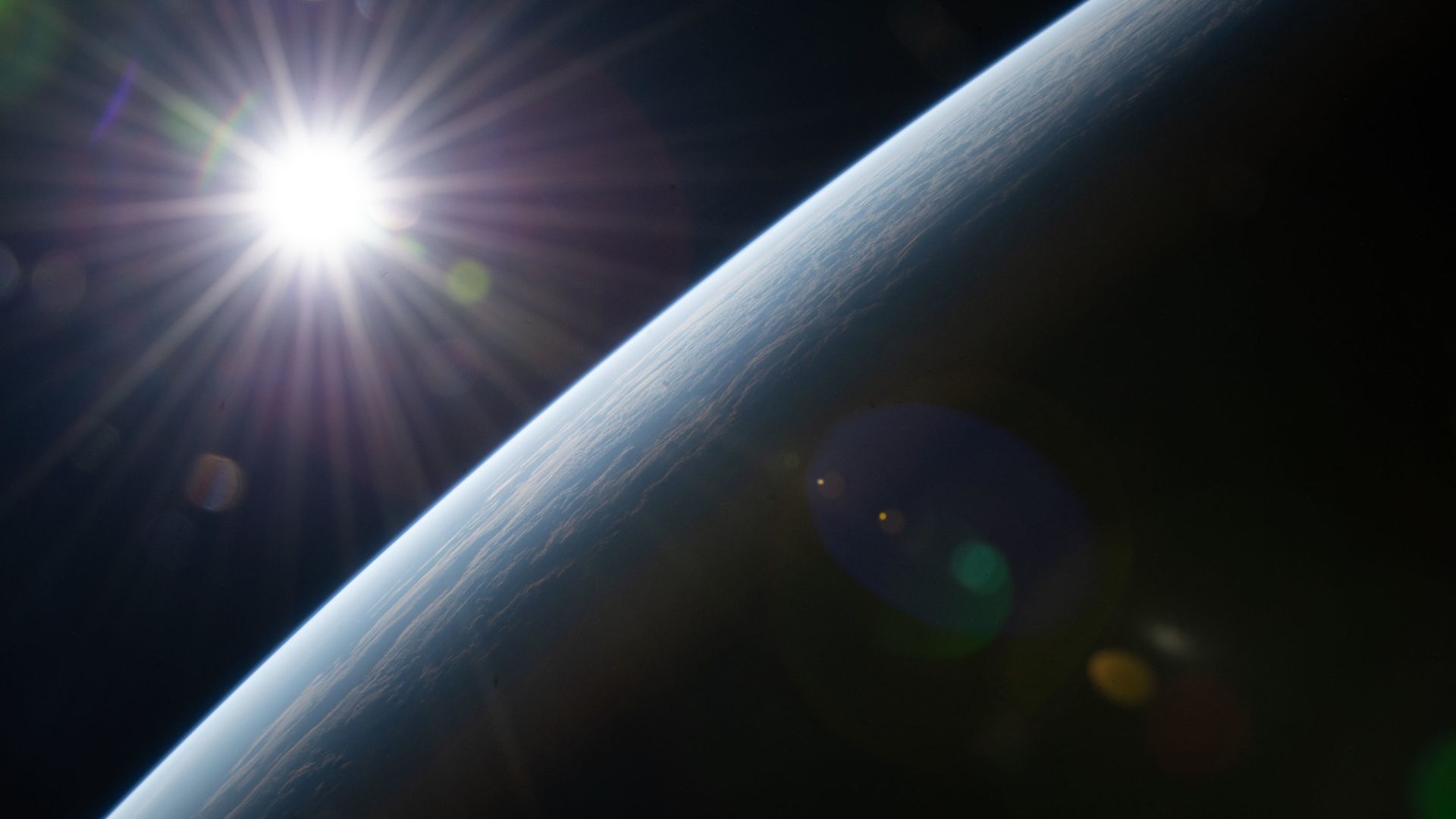| | | | | | | | | | | Axios Space | | By Miriam Kramer · Jul 05, 2022 | | Thanks for reading Axios Space. At 1,233 words, this newsletter is about a 4½-minute read. - Please send your tips, questions and startup space company ideas to miriam.kramer@axios.com, or if you received this as an email, just hit reply.
| | | | | | 1 big thing: The space industry bubble |  | | | Illustration: Sarah Grillo/Axios | | | | The space industry could be facing a shake-up as venture capital money threatens to dry up amid fears of a looming recession. Why it matters: Startups in the space industry tend to push innovation forward and keep established companies — like Lockheed Martin, Northrop Grumman and even SpaceX — on their toes. - Governments and companies also rely on the space economy — which was estimated at about $370 billion globally in 2021 — for communications, agricultural information, national security and other parts of everyday life.
What's happening: The economic downturn could precipitate the long-predicted bursting of a bubble that could affect some parts of the space industry. - Space-focused startups have been on a mostly upward trajectory for years, bolstered in part by venture capital funding that keeps young companies afloat as they build their businesses.
- If that money dries up in a downturn, it could mean that companies that are still trying to get their businesses off the ground will fail before they can get started.
- "Emerging industries are heavily reliant on venture capital due to the fact that these are nascent markets and there are very few customers outside small government tech dev programs," says Chad Anderson, managing partner at Space Capital.
- These companies also have added risk due to the fact that their business plans can often rely on other technologies that are still in the development phase, Anderson added. "It will take real grit, determination, and probably a bit of luck for companies in these industries to make it through this market correction."
Between the lines: The parts of the industry that are expected to be hardest hit include those focused on far-future concepts like asteroid mining and startups working to innovate new rocket concepts that take a large amount of upfront funding. - Those two parts of the industry — launch and emerging industries — only make up about 10% of total investments made in the space economy, Anderson says.
- "The upcoming financial winter will not sustain a meaningful portion of New Space startups that are pursuing nascent markets and selling primarily to other New Space startups," Anton Brevde, a partner at Prime Movers Lab, wrote in a Medium post.
- "You'll certainly end up with fewer companies with marginal business cases or marginal business operations," Carissa Christensen, founder and CEO of BryceTech, said. The industry will also probably "end up with less innovation in some quarters."
Yes, but: That doesn't mean the entire space industry is heading for major problems. - While relatively small portions of the industry may end up most hurt by a down market, the rest of the industry is larger and more diverse — encompassing communications satellites, well-established space companies, software applications using space data and more.
- The space industry as a whole also relies on government funding — through NASA and other sources — which should help large portions of it stay afloat through a general market downturn.
What to watch: If the space bubble does pop, it's not clear whether it will be a slow leak or a rapid burst. - But either way, the space industry on the other side of it will be leaner and more focused — if perhaps slightly less innovative — than the one that came before.
The bottom line: "The truth is that many marginal companies were funded during the market mania of the last few years and most of those companies will get washed out in this market correction," Anderson says, adding that this is true across tech, not just in space. |     | | | | | | 2. Here comes JWST |  | | | The Large Magellanic Cloud seen by Spitzer (left) and the JWST. Photos: Spitzer: NASA/JPL-Caltech; MIRI: NASA/ESA/CSA/STScI | | | | NASA is set to release its first images taken by the James Webb Space Telescope next week. Why it matters: This long-awaited milestone will set the stage for the rest of the $10 billion telescope's mission to rework our understanding of how the universe evolved from the earliest galaxies to today. Driving the news: The first photos are set for release at about 10:30am ET next Tuesday. - You can watch a press conference announcing the images via NASA TV at that time, and I'll cover it right here as well.
- NASA has already released some early alignment images taken by JWST, but Tuesday's photos will be the first full-color photos that will show what the telescope can really do.
What to watch: The images are expected to put the JWST's wide range of scientific goals on display. - The first batch will reveal the fine details of star formation, an exoplanet's atmosphere, an incredibly deep image of the universe and more, according to NASA.
- It's still not clear, however, what these images will really look like: "Of course, there are things we are expecting and hoping to see, but with a new telescope and this new high-resolution infrared data, we just won't know until we see it," Joseph DePasquale, of the Space Telescope Science Institute, said in a statement.
The big picture: The JWST is expected to change everything about how scientists understand the early history of our cosmos. - By using infrared light, the telescope will be able to cut through cosmic dust and see farther into the past than ever before, revealing the first galaxies and stars to form in a nascent universe.
|     | | | | | | 3. Bone loss and spaceflight |  | | | Illustration: Rebecca Zisser/Axios | | | | A six-month mission to the International Space Station could cost astronauts years of bone health, according to a new study. Why it matters: Understanding how a person's health is affected by time in space is crucial for space agencies hoping to send astronauts to destinations like the Moon and Mars in the future. What they found: The study, published in the journal Scientific Reports, found that weight-bearing bones — like those in the legs — didn't recover fully from their time in space even after a year on Earth. - "This suggests the permanent bone loss due to spaceflight is about the same as a decade worth of age-related bone loss on Earth," Leigh Gabel of the University of Calgary and an author of the new study said in a press release.
- Astronauts who flew on missions under six months were able to regain density and strength in their legs more easily than those on longer missions.
- That fact could be problematic for NASA's desire to send people to Mars one day, a mission that would take almost two years, round-trip.
Yes, but: The study's sample size — at 17 astronauts — is pretty small, so more research is still needed. - Studies looking at the health effects of spaceflight tend to be relatively small in general — after all, fewer than 650 people have been to space, and even fewer still have stayed there for months on end.
- That could change in the future, however, as private trips to orbit — and maybe beyond — bring more people to space who can then be studied when they come back to Earth.
|     | | | | | | A message from Axios | | The biggest video game news delivered to your inbox | | |  | | | | Get the latest scoops, trends and news from the world of video games with Axios Gaming, delivered every weekday to your inbox. Why it matters: A crucial view into an industry that is an essential part of millions of people's lives. Subscribe for free | | | | | | 4. Out of this world reading list |  | | | Dione (foreground) and Tethys, two moons of Saturn. Photo: NASA/JPL/Space Science Institute | | | | New Zealand joins ASAT testing ban (Jeff Foust, SpaceNews) The Large Hadron Collider will embark on a third run to uncover more cosmic secrets (Juliana Kim, NPR) The FCC authorizes SpaceX's Starlink system to be used on vehicles in motion (Loren Grush, The Verge) Rare, elliptical craters reveal new clues about strange Saturn moons Tethys and Dione (Samantha Mathewson, Space.com) |     | | | | | | 5. Weekly dose of awe: Sunrise from orbit |  | | | Photo: NASA | | | | I've been a space reporter for 10 years, and these types of photos still take my breath away. - In this image, taken from the International Space Station, the Sun rises above Western Australia.
- Crew members on the station experience a sunrise every 90 minutes.
|     | | | | | | A message from Axios | | The biggest video game news delivered to your inbox | | |  | | | | Get the latest scoops, trends and news from the world of video games with Axios Gaming, delivered every weekday to your inbox. Why it matters: A crucial view into an industry that is an essential part of millions of people's lives. Subscribe for free | | | | Big thanks to Alison Snyder, Laurin-Whitney Gottbrath and Sheryl Miller for editing this week's edition. If this newsletter was forwarded to you, subscribe. 💸 |  | It's called Smart Brevity®. Over 300 orgs use it — in a tool called Axios HQ — to drive productivity with clearer workplace communications. | | | | | | Axios thanks our partners for supporting our newsletters. If you're interested in advertising, learn more here.
Sponsorship has no influence on editorial content. Axios, 3100 Clarendon Blvd, Suite 1300, Arlington VA 22201 | | | You received this email because you signed up for newsletters from Axios.
Change your preferences or unsubscribe here. | | | Was this email forwarded to you?
Sign up now to get Axios in your inbox. | | | | Follow Axios on social media:    | | | | | |
No comments